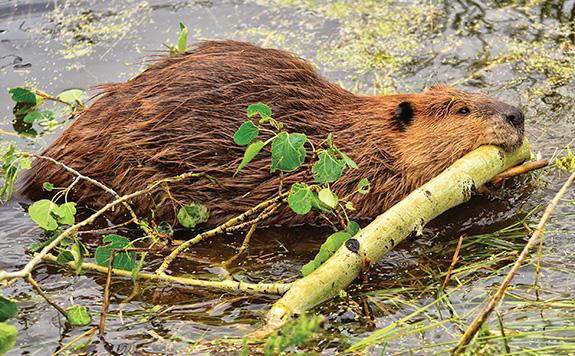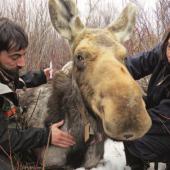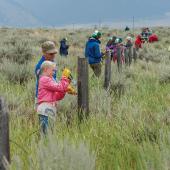Dam Nation
Beaver reintroduction in the Absaroka-Beartooth Wilderness.
Beavers have long shaped the Absaroka-Beartooth Wilderness, their stick-and-mud dams slowing high-meadow streams and creating sparkling pools that teem with life. Despite their historical residency, the AB’s current resident beavers have only been there a few decades, reintroduced after a 30-year hiatus. They arrived (rather inelegantly) on the backs of pack horses, their cages swaddled in canvas and cooled by huge slabs of ice. And they wouldn’t be here at all without the persistence of one stubborn man.
In 1978, the same year these rugged mountains were designated Wilderness, Dan Tyers was hired to patrol the backcountry. Tyers was intrigued by the beavers’ conspicuous absence, noting only long-abandoned beaver lodges and dams. So when the US Forest Service hired him as a wildlife biologist five years later, he decided to bring the beavers back.
“Beavers are described as nature’s engineers,” Tyers explains. “Just by their lifestyle, their ecology, they’re capable of manipulating and repairing systems.”
Famed for their obsession with blocking running water, these herbivores fell trees with only their incisors, positioning the logs to fashion terraced dams. The dams slow water and trap sediment; they enlarge wetland areas and keep willow stands healthy. The resulting habitat supports insects, fish, moose, waterfowl, and songbirds. “Really,” Tyers notes, “it’s a habitat-restoration project in addition to a beaver reintroduction.”
In order to justify the reintroduction, Tyers mapped old beaver structures and prime beaver real estate. He asked old timers about the beavers, arranging interviews with local game wardens, biologists, outfitters, and sheep herders. A story emerged: beavers had thrived in the area until the 1940s or 1950s, when Tyers described a “concerted effort to trap them out.” Around the same time, moose populations boomed, and the ungulates destroyed many of the willow stands required by beavers. A coinciding tularemia epidemic further lowered the beaver population. These pressures, combined with trapping, left the beaver population decimated. Armed with this evidence, in 1986 Tyers gained permission to return beavers to the Wilderness.
In nearby Gallatin and Paradise valleys, beavers were still in residence, occasionally becoming nuisances when they gnawed down shade trees or clogged irrigation ditches and culverts. Tyers live-trapped these unwanted beavers between 1986 and 1999. He resettled them in the Absaroka-Beartooth Wilderness, where there was now a moratorium on trapping.
But beaver reintroduction can be tricky. Tyers only moved beavers in autumn, not too early (or the beavers would move away) and not too late (or they wouldn’t have time to prepare for winter). Beaver families include a breeding pair and kits from the previous two years; if a beaver is separated from its kin it will travel long distances to find them, often perishing along the way. So Tyers kept families together, waiting a day or two to make sure that he had located the entire group, and housing captured individuals in horse trailers outfitted with water tanks and aspen branches in the meantime. Due to the ban on motorized vehicles in Wilderness Areas, Tyers loaded beaver cages onto pack animals for the last leg of the journey to their new homes.
Tyers’s efforts paid off: the beavers survived, and their offspring colonized nearby meadows. He had replaced, in his words, “a missing piece in the ecological machinery.” Over the next 24 years, Tyers made annual pilgrimages to the Absaroka-Beartooth, trekking along the streams to map where beavers were thriving, and which structures had been abandoned. Always pressed for time, he tacked these surveys onto other trips to the backcountry; after inspecting outfitter camps, for example, he would walk a stream on foot, meeting up with colleagues (and his horse) miles away.
In 2009 Tyers, curious about what helped the colonies survive long-term, decided to take the project to the “next level of scientific inquiry.” He recruited then–graduate student Matt Scrafford and a small team of researchers. They found that the beavers had reached carrying capacity—the most individuals that the land can sustainably support—14 years after reintroduction. Colonies persisted longest on smaller, secondary stream channels and meandering, curvy stretches of primary stream with plenty of willow trees.
Willows, which Tyers described as “depauperate” prior to beaver reintroduction, had thrived with the beavers, covering 16% more meadow space in 2011 than they had in 1981. The team hopes that their study will serve as a guide to land managers planning a beaver reintroduction. Scrafford asserts, “Wilderness needs to be managed to have the species that were present historically.”
Reflecting on the decades spent successfully reintroducing beavers to the Absaroka-Beartooth Wilderness, Tyers adds with a laugh, “Well, I lived long enough. It took a lot of persistence.” Now that the beaver reintroduction is complete, Tyers has immersed himself in another project in the Absaroka-Beartooth Wilderness: grizzly bears.
Beavers: By the Numbers
LIFESPAN: 10-15 years in the wild
REPRODUCTION: 1-8 kits per litter, 1 litter per year
FAMILY UNIT: 2-12 members; 1 breeding pair
Adult beavers:
Can stay underwater for 15 minutes
HEIGHT: Stand 1-1.5 feet tall
WEIGHT: 35 to 65 pounds
LENGTH: over 3 feet long, with tail (tails can be six inches wide and 15 inches long)













